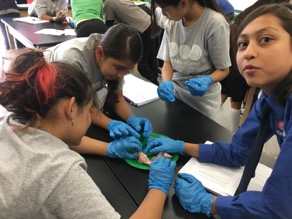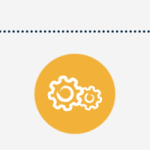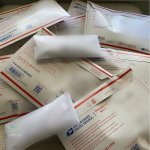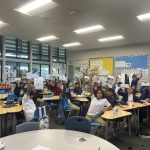Each month, we ask one of the teachers running Letters to a Pre-Scientist in their classroom to write a blog post related broadly to science education. Our first teacher, Lucy Madden, is a 6th grade teacher in Los Angeles and is also part of the LPS Organizing Team.
— — — — —
 We have come to a pivotal point in science education. For a while we have recognized that many of the students graduating our schools are unprepared to problem solve in the real world; educators have struggled to figure out where we went wrong. Our high performing students have skills that allow them to memorize and regurgitate information about a variety of subjects, and they have excellent study habits and classroom behavior. These students perform well on tasks that ask them to describe facts they have learned about.
We have come to a pivotal point in science education. For a while we have recognized that many of the students graduating our schools are unprepared to problem solve in the real world; educators have struggled to figure out where we went wrong. Our high performing students have skills that allow them to memorize and regurgitate information about a variety of subjects, and they have excellent study habits and classroom behavior. These students perform well on tasks that ask them to describe facts they have learned about.
Unfortunately, this is not a skill you need often in the real world. The real world requires that you take your knowledge and apply it to a new situation. It demands you be a critical consumer of the information around you and asks that you make connections between experiences you have had in order to inform future decisions. It demands perseverance. These are the skills our students need to be successful in today’s job market, not to mention in any field of science. These are the skills we must prioritize with our students.
In response to this realization, the Common Core state standards and the Next Generation Science Standards (NGSS) were created. These standards will differ from previous science standards because the NGSS will be implemented on a national level, removing any disparity between what students from each state get taught. In addition, similar to Common Core, these standards raise the bar for our students to ensure they are college and career ready.
 I teach in Los Angeles, California, and have been partially implementing the Next Generation Science Standards since the 2014-2015 school year. These standards are organized into three overarching sections: the Crosscutting Concepts, the Disciplinary Core Ideas, and the Science and Engineering Practices. The Crosscutting Concepts are themes that weave throughout all types of science, such as patterns or scale. The Disciplinary Core Ideas describe the most important science content as divided into life science, earth science, physical science, and engineering practices. The Science and Engineering Practices are skills such as developing and using a model or building an argument from evidence, that are necessary for scientists to be able to collect, analyze and communicate their research in clear, meaningful ways. These three sections are intertwined from kindergarten through twelfth grade, each year building on the one before it to provide a solid and cohesive foundation for our students.
I teach in Los Angeles, California, and have been partially implementing the Next Generation Science Standards since the 2014-2015 school year. These standards are organized into three overarching sections: the Crosscutting Concepts, the Disciplinary Core Ideas, and the Science and Engineering Practices. The Crosscutting Concepts are themes that weave throughout all types of science, such as patterns or scale. The Disciplinary Core Ideas describe the most important science content as divided into life science, earth science, physical science, and engineering practices. The Science and Engineering Practices are skills such as developing and using a model or building an argument from evidence, that are necessary for scientists to be able to collect, analyze and communicate their research in clear, meaningful ways. These three sections are intertwined from kindergarten through twelfth grade, each year building on the one before it to provide a solid and cohesive foundation for our students.
The second thing I have noticed, especially as a middle school teacher, is that students are very resistant to iteration, and struggle significantly at first to being taught this way. There is little room for “remembering” or “identifying” when describing what goes on in my class. Rather, we spend most of our time creating, analyzing, and drawing conclusions.
This way of learning (and teaching!) is a serious adjustment. If you have been taught that the way to get good grades and be successful is by staying quiet and doing your homework, then it is a rude awakening when you are asked to create your own explanation, and the teacher answers your question with a question instead of providing an answer.
I am by no means claiming to be an expert with regard to these standards. I have spent much time over the past f ew years feeling frustrated by the lack of resources available to help me plan. I have spent many late nights creating things for my students based on my interpretation of the standards. But I am a firm believer that these standards are best for kids. They foster curiosity and grit. They build confidence in the face of challenge, and they teach transferable skills that our students can use for the rest of their lives.
ew years feeling frustrated by the lack of resources available to help me plan. I have spent many late nights creating things for my students based on my interpretation of the standards. But I am a firm believer that these standards are best for kids. They foster curiosity and grit. They build confidence in the face of challenge, and they teach transferable skills that our students can use for the rest of their lives.
So far this year my sixth grade students have compared onion and cheek cells with microscopes, dissected a chicken wing to analyze how an arm moves, created marshmallow structures to explore the engineering design process, and debated about whether viruses are living or nonliving.
The days have been far from perfect, and there have been some when I ask myself if the students have learned anything, or if I have just confused them with their own misconceptions. Learning to teach and learn in a new way is a process, but just as I expect my students to try again after failing, I too will continue to grow and encourage the skills and knowledge of the future generation of scientists!




